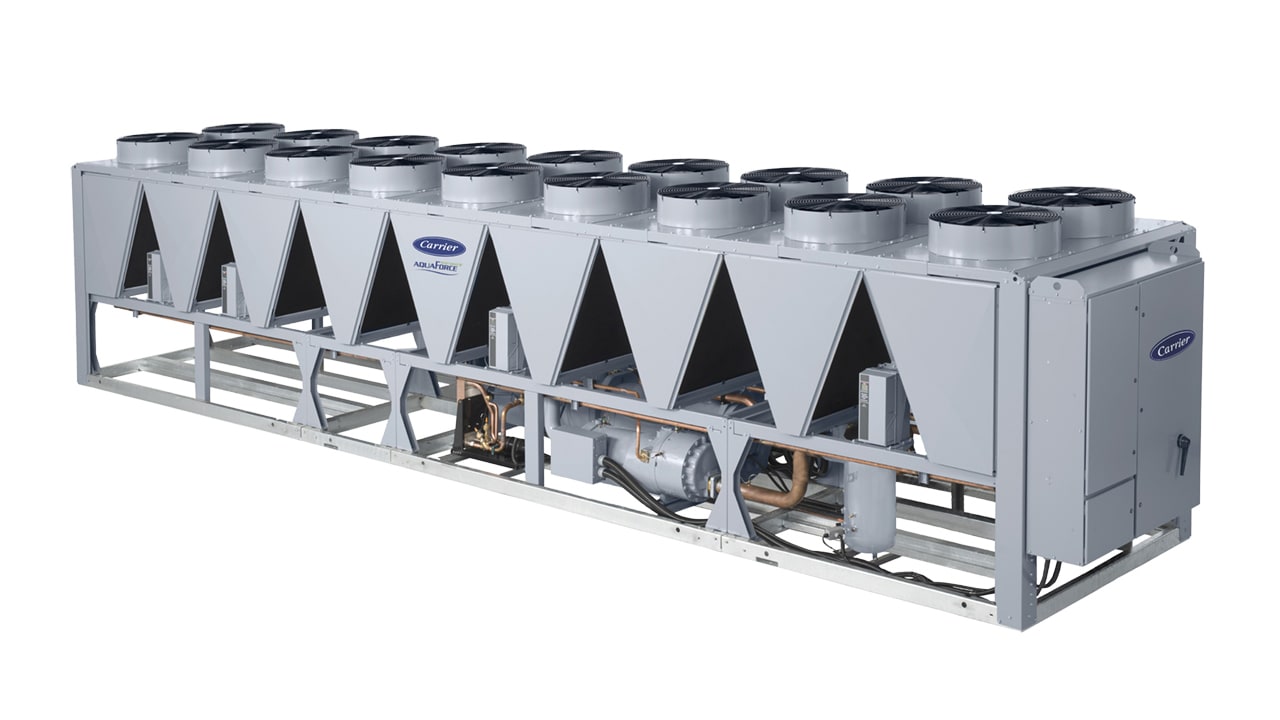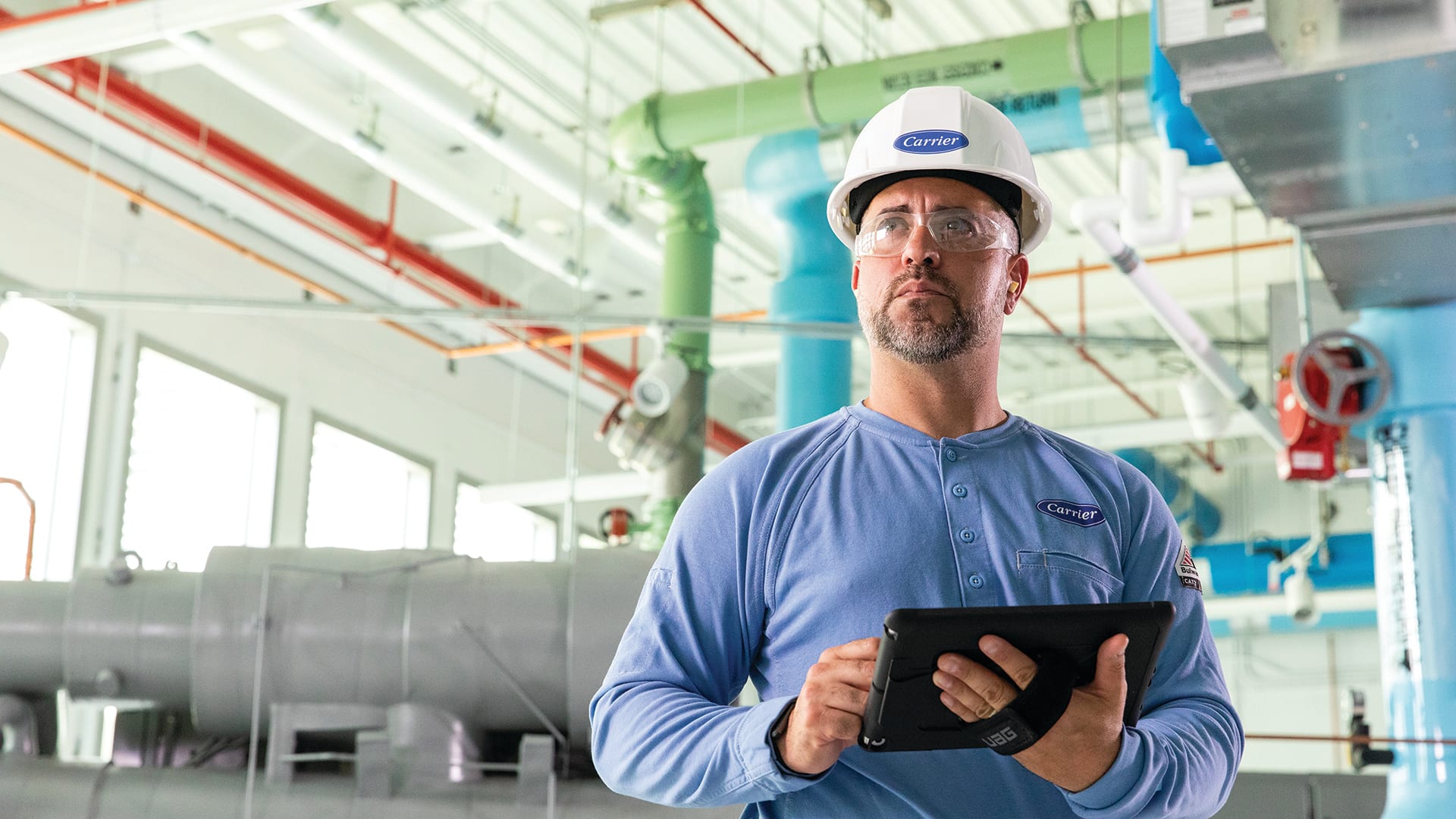

Carrier is committed to helping communities improve learning environments
Learning environments can either promote or deter from student health, wellness and performance.1 At Carrier, our goal is to help administrators, teachers, facility managers, nurses and parents to foster learning environments that help students reach their full potential while streamlining operations to manage costs over time.
Carrier is a top choice for schools looking for support on their path toward healthier, more sustainable and safer learning environments. This is because of our proven success in providing solutions for schools across HVAC, building automation systems, digital solutions and services. Carrier solutions can be catered to match the unique requirement of each school and district throughout solution lifecycles from design to commissioning to ongoing service.

Technologies to Enable Good Learning Environments
Good indoor air quality (IAQ) is essential in K-12 schools, given that students can spend over 90% of their time indoors. The quality of the air inside K-12 classrooms other indoor spaces has never been a more critical issue. It is imperative to evaluate, and if necessary, upgrade and improve essential aspects of a school’s current HVAC and controls system to make sure it delivers the high level of IAQ needed to support key wellness initiatives.
- Filtration, Purification and Ventilation
- Remote Airside Management
- IAQ Monitoring and Digital Solutions
- Remote Energy Management
Greater health and sustainability start with improved building operations.
Carrier offers products, services and solutions that play a critical role in making learning environments healthier and safer for students, teachers and staff. Our innovative lifecycle solutions and customer support that can be customized to fit your school’s unique needs. Carrier’s portfolio includes HVAC & Controls and Digital Solutions & Services, which enables us to partner with schools from design to ongoing maintenance.
Carrier Learning Environment Solutions







Carrier Digital Solutions and Services are tools that can support schools one-time or on an ongoing basis to manage school safety, health, sustainability, and operational needs. Our aftermarket and service teams help to ensure optimal equipment performance to keep schools open, with over 800+ technicians ready to support schools.

Abound is a cloud-based digital platform and suite of connected solutions that uses advanced technologies to aggregate, analyze and visualize data to enable real-time, intelligent, outcome-based results. Abound allows building owners and managers to make decisions for their buildings to be more efficient, comfortable, healthy and sustainable.

BluEdge services offers schools “indoor air quality assessments, wellness services, retro-commissioning, and more” to support a healthier building environment.

NORESCO offers sustainability consultancy services, retrofits, and program management to manage the impact of climate change on buildings.
Defining Optimal School Learning Environments
Student academic and extracurricular performance, safety, health and comfort are impacted by the quality of their indoor learning environments, where students spend over 1,000 hours a year on average.3 “In school buildings, indoor environmental conditions are affected by multiple factors, including occupant density, temperature, lighting conditions, auditory conditions, and indoor air quality.”4
Measurable Outcomes of Optimized Learning Environments



Technologies to Enable Good Learning Environments
The quality of the air inside K-12 classrooms and other indoor spaces has never been a more critical issue, and the experts at Carrier are ready to help. We can help you evaluate, and if necessary, upgrade and improve essential aspects of your school’s current HVAC system to make sure it delivers the high level of indoor air quality (IAQ) needed to support key wellness initiatives.

There is still work to be done to improve school infrastructure across communities to support equitable and ideal learning environments for all students, teachers and staff.
The American Society of Civil Engineers rated the condition of America’s public schools an overall grade of D+, for many reasons including roof leaks, old HVAC systems, pest infestations, presence of asbestos and more.5 In fact, the average age of a school building in America is about 50 years old with some dating back to World War II.6
Case Studies
Carrier’s leadership in K-12 across HVAC, Controls and Service uniquely positions Carrier to partner with school and community leaders to improve learning environments.
Steps to Improve Learning Environments
Students, parents, teachers, administrators and community members have a voice when it comes to improving the community’s learning environments. Now is the time to make your voices heard to take advantage of available government funding for schools to help make schools healthier and safer.
Once educated, you can use your voice to advocate for improvements to the learning environments in your community in multiple ways depending on your role. Below, are specific calls-to-actions and educational resources to help you advocate for improved learning environments.




Indoor learning environments affect anyone who spends significant time in the learning environments, anyone who cares for those who spend significant time in the environments, and anyone who is responsible for fostering positive learning environments. Therefore, learning environments affect those at schools including students, teachers, school staff, in addition to parents or caregivers, school administrators and facility managers.
Those most affected by learning environment quality are students, teachers and staff who work and learn in schools because they can be physically impacted by their learning environments. Parents, caregivers, school administrators and facility managers can be indirectly affected by learning environments because they are responsible for the health, safety and success of those in learning environments and in some cases for the learning environments themselves.
Students & Parents
Students can be physically, mentally and emotionally affected by learning environments, which can be measured through cognitive function and test scores, feelings of well-being and stress, absenteeism resulting from illness related to indoor air quality, and quantity of safety incidents.1,2
Parents, caregivers and other household members play significant roles in protecting the health, safety and success of students and have a voice in decisions affecting the quality of learning environments for their loved ones. For example, parents can participate on Parent Teacher Councils or attend School Board meetings where learning environment improvements are discussed and advocate for projects that improve indoor air quality, school safety and more.
Teachers & Staff
Teachers and staff are affected through impacts to personal health and safety as school occupants, as well as professionally with key performance metrics for their roles. For example, teachers aim to improve student academic success, which can be measured by students test scores, graduation rates, and student satisfaction. Nurses and janitorial staff can be assessed through illness infection rates or school attendance.
School environments can support teachers and staff in achieving their goals. By improving indoor air quality (IAQ), a contributing factor to enhanced learning environments, teachers can augment student learning as improved IAQ has been linked to reduced absenteeism and improved cognitive function.2,3 Furthermore, improved IAQ helps teachers and staff with personal cognitive performance, helping them perform better in their roles.3
Lastly, improved IAQ can support teacher retention, as absenteeism and poor student health are concerns to why teachers are leaving the profession.4 Some changes to improved learning environments have come from teachers and staff who are active voices in their communities. Through groups like education associations, teachers and staff have campaigned to improve infrastructure such as HVAC upgrades5 to better student success, support their roles and improve occupant health.
School Administrators
School administrators play a direct role in learning environment management and improvements as they manage and allocate budgets and school operations. Administrative roles can be at a school level or district level, including principals or superintendents respectively. Administrators spend time with school boards, parents, teachers and staff, ensuring that schools operate sufficiently. Administrators in high-performing schools are measured through KPIs such as average daily attendance rate, reduced operating costs, teacher satisfaction and retention and higher test scores.6,7
School administrators are critical decision makers when it comes to school capital expenditures and other funding decisions. Administrators rely on school boards and other community members to understand the business cases for potential investments to prioritize what should be funded with limited budgets. To prioritize improving indoor air quality in learning environments, administrators need to understand the financial and non-financial benefits of potential solutions, including investments in HVAC. The good news is that improvements to IAQ, including HVAC investments have proven substantial results to occupants.3 These improvements reduce significant operational costs6, therefore making them a lower risk investment in schools.
Facility Managers
Facilities managers are the technical experts that manage, maintain and repair school infrastructure, equipment and facilities management making their role critical to the health and safety of those indoors. Facilities experts can work at the school or district level and are tasked with keeping schools open, clean, safe and healthy for occupants utilizing often limited operating budgets. They are assessed against performance metrics like work order response time, completion time, number of reworks requests, as well as meeting operating budgets.8 Based on the needs of the school, facilities managers can be critical influencers in capital expenditure decisions like solution and vendor selection because of their expertise.
However, many facility managers have struggled with having the technical know-how and understanding the full ecosystem of products and services available to help schools as they deal with labor shortages and retention difficulties.9 This is especially true as new solutions are released to address ventilation, filtration and purification needs and external factors like COVID-19 challenged traditional best practices in facilities management. To help resolve information and labor gaps, facility managers can work with partners like Carrier who provide maintenance services, assessment and design services, replacement parts and recommissioning services and more.
In addition, like students and teachers, facilities experts spend significant time in learning environments and can be physically affected by them as a result.2,5,7
- School Facility Conditions and Student Academic Achievement | escholarship.org
- How To Reduce Student Absenteeism with Indoor Air Quality Improvements
- The COGfx Study
- The Teacher Shortage Is Real, Large And Growing, And Worse Than We Thought
- Governor Announces Proposal to Pay for HVAC System Upgrades | Connecticut Education Association
- State of Our Schools Report
- Indoor Air Quality in High Performance Schools | US EPA
- The Main Facility Management KPIs and Metrics You Should Track | Facilities Management Advisor (blr.com)
- Top Challenges for School Facility Managers | cleanlink.com
Indoor air quality (IAQ) is the “air quality within and around buildings and structures, especially as it relates to the health and comfort of building occupants”.1 Quantitative markers of indoor air quality, like the concentration of pollutant levels in the air, can be measured in real-time so IAQ can be improved before symptoms of poor IAQ manifest, which include headaches, dizziness and fatigue.1 Air quality assessed as part of IAQ include air pollutants including asbestos, CO2, PM2.5 VOCs, and radon.1 Standards set by issuers like WELL Building Standard™, Fitwel® and ASHRAE can be guides to help achieve good IAQ. Decreasing these air pollutants can start improving IAQ in your indoor environment, some of which sourced from building materials, cleaning products, tobacco products, pesticides, environmental and second-hand smoke, and biological pollutants.1
There are multiple ways to understand air quality in classrooms:
- Test air quality using an air quality monitor one-time, continuously or by assessment. Air quality monitors are devices that track IAQ indoors including humidity, fine particles, etc.2 Metrics to watch out for in your indoor environment include TVOCs, CO2, and PM2.5 to help assess your IAQ.3
- Assess the physical room for current efforts towards IAQ, including products for air purification or ventilation. Some questions to ask one-self when assessing if IAQ is being considered: Are there air purifiers being used? Do windows open? Are vacuums being used often? Are we using pollutant-less cleaning products?4
- Check for physical symptoms of poor indoor air quality in the room. Frequent signs of poor air quality can include complaints from school occupants of headaches, cold symptoms and asthma flares.5 However, we recommend understanding IAQ in your classroom before symptoms occur. HVAC professionals like Carrier can help schools address IAQ concerns before symptoms occur.
Indoor air quality can be tested through monitoring (one-time or continuous) or assessments, and then verified through air quality certifications.
Air Quality Monitors
Indoor air quality (IAQ) monitors are devices that track IAQ indoors including humidity, fine particles, etc.1 They are easy to procure, generally are smaller than a tissue box, and measure air quality within a defined square footage range. Monitors can detect IAQ measures including CO2, PM2.5, humidity, radon, temperature, etc.1,2 Monitors can be used in a room to measure IAQ continuously or at a point in time. Furthermore, monitors can alert occupants when performance metrics step outside of approved ranges, for example when CO2 gets too high so that occupants or operations managers can take action to improve indoor air quality. When combined with digital platform solutions like ABOUND™, monitors can provide school operators a complete picture of IAQ classroom by classroom or school by school within a district to enable them to better manage IAQ. Monitor accuracy is dependent on placement and best practices can be found in the WELL Performance Verification Guidebook.3 Air Quality monitors can help you establish a baseline for IAQ and assess and select solutions, if needed, to improve indoor air quality.
IAQ Assessment
In addition to air monitors, air quality can be measured through point-in-time IAQ assessments, which are typically more holistic than monitoring alone. Assessments can include using a monitor to test for indoor air quality throughout a building but can also include assessing building system(s) performance that affect air, like HVAC and controls, as well. Assessments generally measure building system performance and indoor air quality against a set standard (e.g., CCHAS, WELL, ASHRAE) and can be completed in-house, or via a third party like Carrier. Assessments can be used to determine your air quality, develop strategies to improve air and plan next steps to bring solutions to life.4 To learn more about IAQ Assessments by Carrier and for a detailed view of our offering, click here.
Building Site Certification
Building site certifications are third party verifications that indicate a building meets or exceeds a minimum standard, generally at annual intervals. Common building site certifications include WELL, LEED®, Fitwel, and BREEAM.5 Certifications are usually shared publicly at building entrances to reassure occupants that building performance supports desired outcomes, like building health or sustainability. Site certifications require assessments and metrics to verify standards are met. For example, Carrier’s Certified Healthy Air System (CCHAS), assesses and certifies that building systems support Carrier’s certified ratings for indoor air quality.6
- ABOUND™ by Carrier| Healthy & Efficient Buildings
- Introduction to Indoor Air Quality | US EPA
- WELL Performance Verification Guidebook Q1 2019 | storyblok.com
- IAQ Assessments | Carrier
- Top 11 Green Building Certifications That Can Increase Your Property’s Marketability | SharpLaunch
- Healthy Buildings | Improving Indoor Air Quality | Carrier Corporate
Schools have multiple available strategies to choose from to improve learning environments1, especially indoor air quality that can be layered to optimize results.2 The overall strategy should consider constraints including current infrastructure limitations, funding availability, feasibility given timelines and more. Regardless, of constraints there are immediate actions a school can take to improve learning environments quickly as they select longer term strategies and solutions.
Quick win solutions are generally fast and cost-effective to implement relative to larger scale solutions. Below are actions that can be taken quickly to positive impact learning environments in schools.
- Improve classroom ventilation and air circulation which can “reduce sources of health problems, inhibit the spread of airborne infections, help keep pollutants, stale air and mold growth out of the classroom.”1 American Society of Heating, Refrigerating and Air-Conditioning Engineers (ASHRAE) recommends 5-6 outdoor air ventilation rates (air changes per hour) for schools (excluding lecture halls).3
- Ensure classroom doors and windows are operational, and open windows4 frequently as weather permits to bring in more outdoor air and increase natural light
- Utilize existing equipment including HVAC systems or other equipment to increase air circulation, ventilation and more
- Use a humidifier in classrooms and larger school spaces to sustain 40-60% humidity levels, and maintain over time5
- Allow for more periodic outdoor time as part of the school day to increase outdoor air exposure
- Improve air filtration to capture indoor air pollutants and mitigate airborne disease transmission.2 ASHRAE recommends schools use a MERV-13 filter or higher.6 MERV ratings (minimum efficiency reporting values) rate a filter’s ability to capture particles of various sizes, the smaller the particles that can be filtered, the higher the MERV rating.7,8 HEPA filters are highly effective and exceed the minimum ASHRAE recommendation.
- Upgrade to HEPA filters which can remove “at least 99.97% of dust, pollen, mold, bacteria, and any airborne particles with a size of 0.3 microns”8, or MERV-13 or higher filters as systems allow
- Replace existing filters on a periodic basis9
- Use an air conditioner with proper filters or air purifier in classrooms (or multiple in larger areas)9
- Clean the classroom to prevent the accumulation of clutter and dust and reduce the build-up of pollutants to support student and teacher productivity and health.4
- Clean classrooms more frequently including mopping floors, cleaning fabrics4 and take trash out sooner
- Use cleaning products that are free from harsher chemicals and materials10
- Collaborate with facility managers or third parties to assess building systems and recommission equipment to original design parameters
Additional strategies to improve learning environments that can be applied at scale and generally require capital expenditure, are listed below. The solutions listed below are HVAC focused and typically deliver more robust results but take longer to implement and are most costly. However, air quality solutions, including HVAC solutions can be instrumental in transforming your school’s IAQ. For existing schools, we recommend taking an Assess-Select-Monitor approach to help determine your IAQ needs.
- Assess: The first step is to assess the indoor air quality of your school to determine a current state baseline, identify areas of improvement, and inform solution selection. Assessing first against a chosen standard can help schools balance the needs of multiple classrooms or rooms, and help districts prioritize improvements across schools. To learn more about how to assess your school’s IAQ please see the FAQ: “How can I test indoor air quality?”
- Select: Next, schools can explore solutions to address ventilation, filtration and purification needs. Oftentimes, schools lack internal resources and expertise to do this independently and rely on partners like engineers or consultants to determine which solutions are best. Carrier offers new equipment like chillers and rooftop units that can improve school environments, and for schools with existing equipment, controls are also offered that can be used to achieve desired outcomes like improved indoor air quality based on occupancy.
- Monitor, Control & Maintain: Once a solution is installed, monitoring indoor air quality can help manage IAQ on an ongoing basis, enable continuous improvement and track return on investment (ROI). For example, cases for ROI can be tied to controlled HVAC usage based on school occupants, optimizing for cost and environmental outcomes.11 Solutions that can optimize benefits include digital IAQ monitoring tools like Carrier’s Abound™ system which can help schools manage IAQ levels and energy consumption. Using both monitoring and controls allows for more proactive maintenance of IAQ and energy usage, to ensure ROI can be achieved.
- Indoor Air Quality in High Performance Schools | US EPA
- Let's Clear The Air On COVID | OSTP | The White House
- ASHRAE Recommended Air Changes Per Hour | Smart Air
- Take Action to Improve Indoor Air Quality in Schools | US EPA
- Op-ed: Humidity can aid in the fight against COVID-19 | Harvard University
- Air Cleaners, HVAC Filters, and Coronavirus (COVID-19) | US EPA
- ASHRAE Epidemic Taskforce
- What is a MERV rating? | US EPA
- David Gitlin talks about surging air conditioner demand amid coronavirus pandemic | CNBC
- Cleaning Supplies and Household Chemicals | American Lung Association
- River Trails Middle School | Better Buildings Initiative | Energy.gov
School administrators, like superintendents and school boards are those typically involved in funding allocation decisions and capital expenditures for school facility improvements, including those committed to improving learning environment quality.1 Superintendents and school boards play different roles, but both are important in addressing Indoor Air Quality (IAQ) issues in schools.
Talk to Superintendents and School Boards about:
- Allocation of ESSER Funds toward HVAC and IAQ improvements
- Allocation of capital budgets toward HVAC and IAQ improvements
- Prioritization of HVAC investments relative to other options
- Increase in budget for school capital expenditures
- Importance of IAQ and quality learning environments
- What is currently being done to improve learning environments
- Progress toward learning environment improvements
Indoor environment quality (IEQ) is the “indoor conditions in a building related to the health of those who occupy it”.1 The definition is broad and includes indoor air quality, lighting, thermal conditions and moisture.2 Issues regarding IEQ can be assessed through their effects on occupants such as respiratory symptoms related to damp building conditions.1
Indoor air quality (IAQ) is “air quality within and around buildings and structures, especially as it relates to the health and comfort of building occupants”.3 IAQ issues may show up after long-term exposure, while others may experience more immediate effects. Symptoms of poor IAQ include nose, throat and eye irritation, dizziness, headaches and fatigue after single or multiple exposure to contaminants.3 IAQ is a contributing factor to overall building IEQ; both being linked through current ventilation standards today by the agency, ASHRAE (American Society of Heating, Refrigerating and Air-Conditioning Engineers).2
IEQ and IAQ both measure outcomes of indoor building conditions but IEQ has a broader scope of what is considered to determine quality compared to IAQ, which focuses solely on air. The scope of IEQ includes building IAQ, as well as measure for lighting, ergonomics and anything else that impacts occupant health.4 Carrier solutions can positively affect both IAQ and IEQ by improving building health, safety, and sustainability. For example, Carrier’s Abound platform can show occupants their energy consumption and air quality in a single interface using sensors and third party information to help schools manage their IEQ and IAQ.5 Carrier’s commitment to our customers and continued innovation has made Carrier a preferred partner for schools to improve school learning environments by making them healthier, safer, more sustainable and more comfortable for occupants.
Schools can get started creating an IAQ strategy by first determining if one has already been created in the past by validating with school administrators. If one does not exist, schools take the following steps to create an IAQ plan for you school using the EPA’s IAQ Management Framework: Organizing, Communicating, Assessing and Planning.1
Organizing involves putting together a customized approach for your school, getting the right stakeholders involved and building a team to execute after a plan has been created.1 Carrier can assist schools or districts in designing their IAQ plans and setting realistic and science-backed goals for their learning environments.
Communicating involves letting community and school members know of IAQ programming being developed, and being transparent with IAQ importance, as well as intended outcomes.1 Carrier provides educational resources to help engage your community in efforts to support better learning environments. Carrier representatives have spoken at School Board meetings, government-led webinars, and other events to spread awareness of healthy schools and indoor air quality.
Assessing is putting into action some of the goals being developed beginning with establishing a current state baseline. Carrier can be a helpful partner to schools to assess current state of IAQ and building system operations through digital solutions such as ABOUND or services like IAQ assessments. To learn more about how we can help, Contact a Carrier Expert or see FAQ, How Can I Test Indoor Air Quality?”.1
Finally, planning is developing detailed goals based on, current state and high-level goals of the overall IAQ program to create a workplan.1To see how Carrier has supported schools to improve IAQ see these case studies:
- New Carrier HVAC Solution Will Boost Gallipolis School District’s IAQ and Energy Efficiency
- Cherokee County School District Improves IAQ with ABOUND IoT Platform
- Southern California School District to Install 3,700 Carrier OptiCleanTM Units to Help Improve IAQ for Students, Teachers and Staff
Please visit the EPA for a list of case studies of how schools like yours have improved IAQ: Framework for Effective School IAQ Management | US EPA